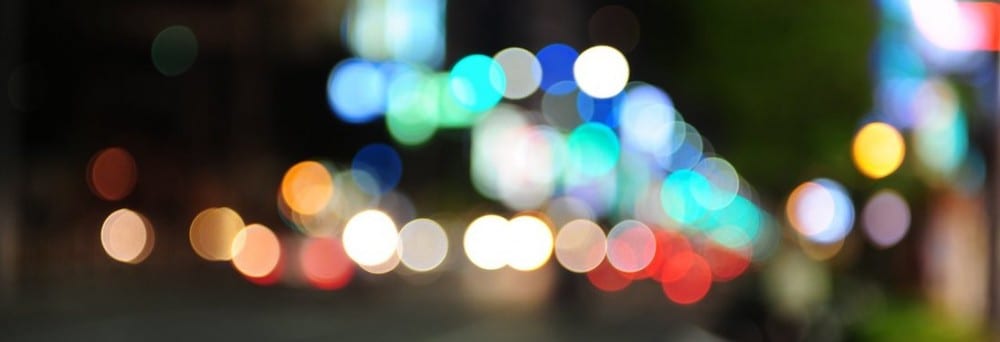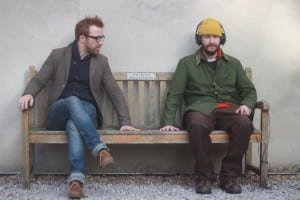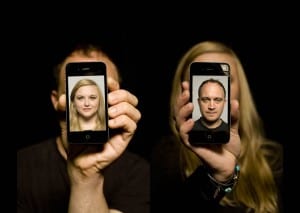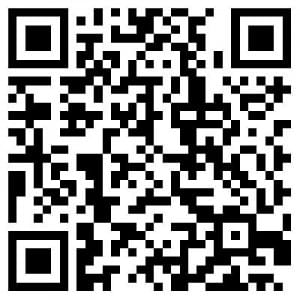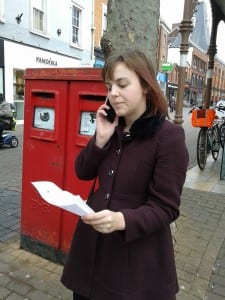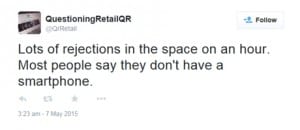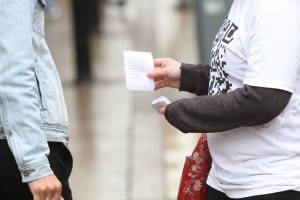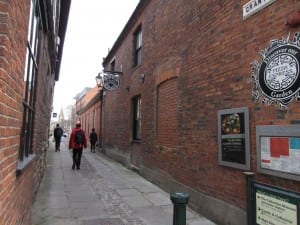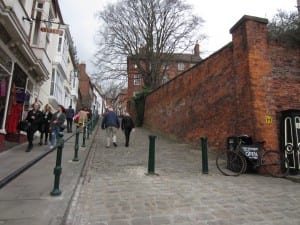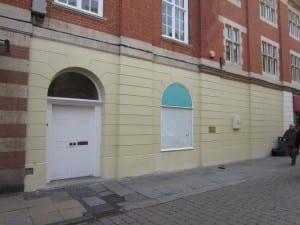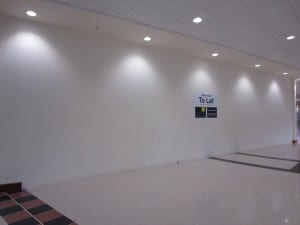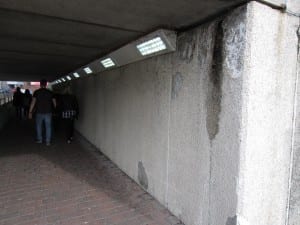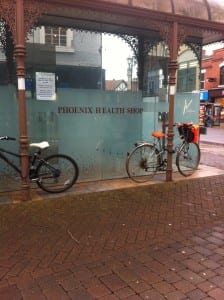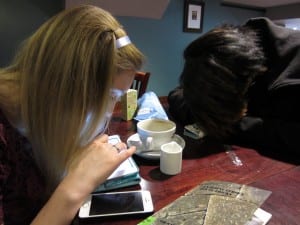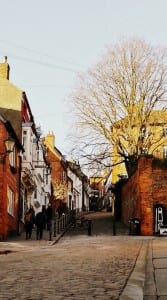Framing Statement
Our process was highly controlled by the influences that we had. Due to the fact that we were not only being assessed for our university course, but also possibly being picked for Frequency Festival in October 2015, we had to take into consideration Frequency’s brief too. Frequency Festival saw fit that this year’s theme would be “liberation, as part of the celebrations of the 800th anniversary of the signing of Magna Carta” (Visitlincoln, 2015).
Our performance Questioning Retail, which was a play on the original name of QR codes, was created around this theme to liberate our audience from consumerism. Our piece was based in Lincoln High Street, between the hours of 9am and 5pm on the 7th of May. During our piece, we were stood in the High Street, wearing QR codes on t-shirts and handing out flyers. On these flyers we had a range of QR codes that took our audience to a series of websites, YouTube videos, texts, etc. Having this kind of content in our QR codes allowed us to explore such things as, the process of our performance, the history of Lincoln High Street, social interaction in the High Street, the Economy and the environment. Flyering allowed us to create a performance, where by the naked eye we looked like annoying, everyday promoters, but in reality, we were actually trying to accomplish the opposite, and stop our audience from the consumerism for a moment.
Using our stimulus ‘liberation’, we were attempting to disrupt the every day congestion of the high street, even if it was just for a moment. We wanted to do this so that we would liberate our audience from the consumerist society that they live in. Therefore, disrupting the flow of ‘cattle’ for a small amount of time, to make them question themselves, and the consumerist site that they shop in. Part of Frequency’s brief was that we also had to incorporate pervasive media into our performance; this was why we chose to use QR codes. We wanted something that would catch an audience members eye, and make them look long enough to want to scan our t-shirts. By having large QR codes on our t shirts allowed us, as a group, to look different to the every day high street user. Although our look was that of a promoter, our content was a complete juxtaposition of this. The content on our t shirts and flyers was made to surprise our participants, for example, QR codes have “increasingly been used as a marketing tool” (marketingdonut, 2015). However, we wanted to change this and use QR codes against their original concept. We wanted to essentially question retail with them.
Analysis of Process
“Contrary to popular belief, breakthrough ideas don’t always come out of the blue like a sudden stroke of lightning” (James, 2014). This statement proved true to us during our process, as many of our ideas were stopped by obstacles.
When starting site specific, I didn’t really know what to expect. I had asked a few third years for their feelings on the subject, and I received many mixed opinions back. However, after a lesson on pervasive media and an exciting workshop with Wes, I started to understand what Site Specific actually was. Our workshop with Wes was a new and interesting way to look at performance. He showed us a software called MaKey MaKey which really interested me. Through this, Wes showed us how to make music with banana’s. Through the use of the bananas linked to the MaKey MaKey software, you could create music just like a keyboard. After the lesson, I went home and had a look at this YouTube clip:
It was amazing what you could do with a simple bit of software. During this workshop with Wes, we learnt about QR codes. All five of us had seen them before, mostly used for marketing purposes such as at the bottom of posters or on the back of McDonald’s cups, etc. However, none of us had made one before. Wes showed us how to create them, explaining that we could put any kind of content in them whether it be a URL, a piece of text or an image. Using the techniques that we had learnt with Wes we went away to think about our performance. At this point we had three separate ideas.
Our three ideas.
Our first idea was driven by Michael Pinchbecks’ Sit with me for a moment and remember.
This inspired us to think about creating a piece of work in a performance space, which would be situated in Lincoln High Street, but would aim to take a participant out of that environment. Michael Pinchbecks’ performance inspired this, as his idea to invite a participant to “sit on the bench for five minutes to listen to a recording that reflects on what it means to sit for a moment and remember.” (wordofwarning, 2015) was very inspirational. We liked the idea of taking a participant out of their surroundings via the use of an audio clip. After listening to Pinchbecks’ audio track, I decided to explore the high street for a while to study the general public. While doing this I found that many people walked with a sense of purpose, not even taking a second look at the others around them, while others buried their faces in their phones and stayed disconnected from the rest of the world. Our group collaborated during the week, via Facebook. We spoke about the idea and our research, we read into Carl Lavery’s 25 Instructions for performance in cities, finding that his seventeenth instruction was to “create a forest in the city”(Lavery, 2005, 236). We wanted to create something that would take a participant out of the consumerist area and put them in a completely juxtaposing place. We wanted to create an instillation of an island which would include two deck chairs, where a participant would join one of us and have a conversation.
Our second idea consisted of using the MaKey MaKey software to create a performance, whereby the participants could touch our hands via the use of something, for example a high five. This would then project our content onto a wall. However, this idea was quickly scrapped as we would have needed an indoor space such as a small shop or a studio.
Finally, our last idea excited us all with the possibility that we had found a solid idea for our performance. We looked into using QR codes and the content in which we could put in them. After much deliberation we came across the idea to have two QR codes each, one on both the back and front of our tshirts. The problem that we were having was what to put into the QR codes. After deciding to choose the QR code idea over the first two, we started to think about the content.
When initially visiting our potential sites; the Lincoln High Street and the Brayford; two very different and contrasting places. Many thoughts and inspirations developed from these sites. Thus starting my initial process. I started by visiting the busy Lincoln High street, observing the busy hustle and bustle of passersby. Too busy with their own little worlds to notice others around them, the cars rushing about to and from different places on and around the high street.
Therefore “the city becomes the location of performance. Performance serves to present recognisable places in unfamiliar ways, from unexpected perspectives. And to reveal unfamiliar locales: rarely visited but just adjacent to the flow of everyday life” (Pearson, 2010, 41). All that came to mind when observing this was how busy it was and how nothing stopped, people lost in a sea of many others driven by their own paths. As a response to this, our group decided that we would video them at peak times during the day. The six places that we chose to video, were places that we felt that people seem to be most oblivious to the happenings around them. Places that even we ourselves, would blend into our surroundings. Filming in Time Lapse allowed us to speed these busy places up and show just how many people walk/ drive through these places in a short amount of time. When looking back at the video now, it allows us to imagine the Lincoln high street fifty of sixty years ago. It allows us to see the metaphorical ghosts of how many people have walked those streets in the past years. Pearson states in his book “I evoke this place fifty years ago: performance as a lens or filter, residing exactly over the current everyday” (Pearson, 2010, 55). In contrast to this site was our other potential site, The Brayford. To many people passing this waterfront it’s just water, boats and swans. To me however, the Brayford is a place where I can think about home. I get a strange nostalgic feeling from this particular waterfront; it takes me back to times when I am home with my family. When looking at the Brayford I get a sense of nostalgia from the water. I remember my family and I feel a longing to see them. Both sites were very contrasting and different. However, we decided that we could use both of the sites in a unique way. We decided that we would wear tshirts with QR codes on them. Originally we wanted the QR codes to be of things in the city that remind us of memories etc, due to personal reflections and feelings from our sites. This would allow us to work around both sites, showing potential audience the thoughts and different perspectives of these two very different places that they take for granted every day. We got the idea to do personal stories from the performance I Wish I Was Lonely.
This performance was about technology and how everyone is so busy in their own little bubbles, on their phones etc. However, the performance was broken down with true stories. This influenced our final piece because we liked how the audience could be invited to use their technology and scan us.
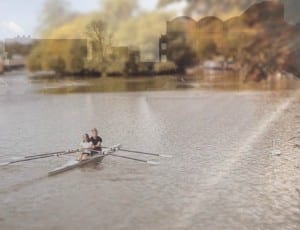
– Superimposed picture of the River Witham (Brayford, Lincoln) and the River Great Ouse (Bedford) with me rowing.
Finally, we came up with a solid idea for our performance. I looked back at Carl Lavery’s 25 Instructions for performance in cities as I had remembered seeing his twenty-first instruction. “Decorate a prominent multi-storey car park with wallpaper”(Lavery, 2005, 236). After I spoke to the group about my findings, we planned to create a piece of instillation which we would put up on a wall in the high street. On the day we planned to create QR codes via the use of a laptop and a printer. We wanted to fill the content of our QR’s with our process, history of Lincoln High Street, social interaction in the High Street, the Economy and the environment. By using a durational performance, we wanted to create a piece of art that would draw our audience from their consumerist high street and make them stop and look for a while. When we had decided on what we were to create, we set about looking for places to put up our instillation.
Straight away we found a prefect location for our instillation on speakers corner. We called the number on the side of the building and were immediately tossed between the council and the Phoenix Health Centre. We were so close to finding the perfect place for our performance, but soon we were told that we were unable to use the building.
We searched for another building in which we would be able to create our performance. After a couple of days of looking, we came across the wall owned by M&S. We were excited as this wall was huge in height, and although off of the public high street slightly, it would still have caught their eyes. We spoke to M&S, asking if we could use their wall. However, after an email back from them, our excitement was once again shot down. We had no where to put our instillation.
After speaking to Conan about the unlikelihood of finding another wall in the High Street, we thought about trying to change our piece.
How could we do something similar, yet not use a wall?
Finally we answered this question by coming up with the QR code flyers. This allowed us to forget the stress of finding a wall and let us focus on the content in which we wanted to fill our QR codes with.
We already knew what we wanted our content to be, this allowed us to set out creating it. As our original idea with the QR codes was to create an art installation live in the high street, I decided that showing the process would allow the audience to seem more involved, and it also allowed them to see the progression of the piece. Even when the idea changed it was still relevant to show the audience the way that we came up with the idea, particularly as we are possibly the first performance group to use QR codes.
Even during our performance, I stuck to the process of our piece. I did this via the use of a live Twitter feed. This allowed us to create a constant update on how our team was developing even through the duration of our performance.
Performance Evaluation
As a result of our performance, Questioning Retail, we found that despite our original worries about audience members not taking part, we were actually overwhelmed by the amount of participants that actually did. Even though our original concept of an instillation didn’t go to plan, our performance seemed to work better than we had wished.
To attract our audiences attention originally, we would ask them one of the following questions:
- Do you have a smart phone?
- Do you know what this is? (We would then point to our t-shirts)
- Do you have a QR code reader?
I chose to address our audience with the question ‘Do you have a smart phone?’ as according to statistics “the number of smart phone owners has reached 72 per cent in the UK” (Mobilemarketing, 2013). When participants said that they did have a smart phone, we asked them if they would like to take part in our performance. We then offered them a flyer containing a QR code. Throughout the day, we had several different reactions to this; these included a mixture of feedback’s, mostly being positive however.
Although we got many people purposely avoiding us, for example:
We did however, get people who stopped and listening to what we had to say:
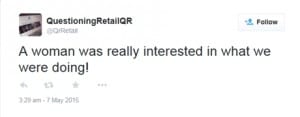
Our Twitter page live feeding the process of the day.
A lot of people simply took a leaflet and left, however there were a few who embraced us with conversation. For example, a man in a tweed jacket stopped to listen to what I had to say. He was so interested that he took a flyer from me, folded it and put it into his wallet, saying that he would get his son to scan it for him to view later. It was people like him that made us realise that our performance was actually functioning in the way that we had planned.
After we spoke to Conan and Wes about our performance, the question we additional addressed our participants with had somewhat changed, from ‘Do you have a smart phone?’ to ‘We shop too much’. This change of dialogue, although we felt it was less approachable and a little bit more oppressive, it appeared to interest participants in our work and was direct into the point of our piece.
Overall, if we were to perform this piece again, we said that we would like to have had a live process on the day. By asking participants to put their own comments/thoughts into a QR code we could have printed them onto paper and handed those out as flyers too.
Although this would have been effective, I feel that our performance allowed us to do what we originally set out to do, which was to stop our audience in their consumerist tracks.
References
Howell, A. (1999) The Analysis of Performance Art: A Guide to its Theory and Practice. Wiltshire: Antony Rowe Ltd.
James, G (2014) How to Come Up With a Breakthrough Idea. [online] Available from: http://www.inc.com/geoffrey-james/how-to-have-a-breakthrough-idea.html [Accessed 13th May 2015]
Lavery, C. (2005) Teaching Performance Studies: 25 instructions for performance in cities. Studies in Theatre and Performance, vol 25, no. 3
Marketingdonut. (2015) Q&A: Mobile marketing with QR codes. [online] Available from: http://www.marketingdonut.co.uk/marketing/direct-marketing/q-a-mobile-marketing-with-qr-codes [Accessed 13th May 2015]
Mobilemarketing. (2013) 7 in 10 People in the UK Now Own a Smart phone. [online] Available from: http://mobilemarketingmagazine.com/7-10-people-uk-now-own-smartphone/ [Accessed 13th May 2015]
Pearson, Mike. Site-Specific Performance. Houndmills, Basingstoke, Hampshire: Palgrave Macmillan, 2010. Print.
Visitlincoln. (2015) Frequency Festival of Digital Culture 2015. [online] Available from: http://www.visitlincoln.com/whats-on/frequency-2015 [Accessed 13th May 2015]
Wordofwarning. (2015) Michael Pinchbeck: Sit with me for a moment and remember. [online] Available from: http://www.wordofwarning.org/archive/2012-hazard/pinchbeck/index.html [Accessed 13th May 2015]
